
 Data Structure
Data Structure Networking
Networking RDBMS
RDBMS Operating System
Operating System Java
Java MS Excel
MS Excel iOS
iOS HTML
HTML CSS
CSS Android
Android Python
Python C Programming
C Programming C++
C++ C#
C# MongoDB
MongoDB MySQL
MySQL Javascript
Javascript PHP
PHP
- Selected Reading
- UPSC IAS Exams Notes
- Developer's Best Practices
- Questions and Answers
- Effective Resume Writing
- HR Interview Questions
- Computer Glossary
- Who is Who
Parallel Lines and Angle Relationships
Introduction
Parallel lines are lines never meet at any point, and the distance between two lines is the same. In geometry, straight lines may be intersecting or non-intersecting lines. Intersecting lines make an angle with each other, whereas non-intersecting lines do not make any angle with each other. Parallel lines are lines which do not intersect each other. Each point in a parallel line is equidistant from its corresponding point in the other line. Intersecting lines make angles among themselves from 0 degree to 360 degrees. In a two-dimensional plane, two or more lines can be intersect, parallel, and perpendicular in geometry. Lines may be defined as perpendicular, parallel, transversal, etc. In this tutorial, we will understand parallel lines, transversal lines, angles formed by parallel lines and a transversal line, corresponding angles, alternate interior angles, and alternate exterior angles. We will also learn about angles on the same side of transversal lines and some solved examples on these topics.
Parallel Lines
If two lines in a two-dimensional plane do not intersect with each other even when extended to infinity, the lines are called coplanar lines or parallel lines. In other words, if every point on these lines is equidistant from its corresponding point on that plane, the lines are said to be parallel lines.
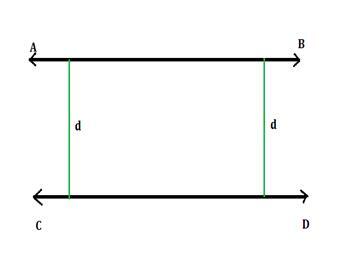
Transversal lines
If two parallel lines in a two-dimensional plane are intersected by a third line at two different points, the third line is known as transversal line.As shown in the figure, a transversal line PQ, intersects lines AB and CD at two points. The transversal line forms eight different angles with each other, which we shall discuss further.
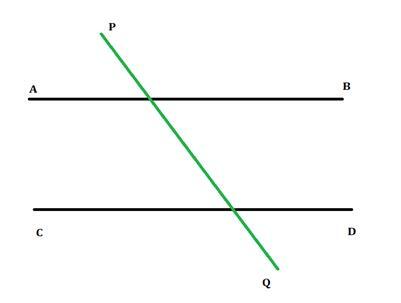
Angles Formed by Parallel Lines and a Transversal
Consider the figure given below. In the figure, line AB is parallel to line CD, and a transversal line PQ transverses through the parallel line.The transversal line intersects the line AB at X and the line CD at Y. As shown in the figure, the transversal line forms eight angles with lines AB and CD. These angles have some relationships with each other, which help us in determining angles between lines.
Different types of angles formed by a transversal line are discussed ahead.
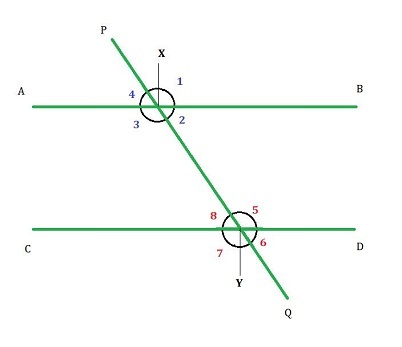
Corresponding angles
An exterior angle formed by the transversal line on the first line and the interior angle formed by the transversal line on the second line on the same side of the transversal line are said to be corresponding angles. In the figure given below $\mathrm{\angle1}$ is a corresponding angle to $\mathrm{\angle5}$, and $\mathrm{\angle4}$ is corresponding angle to $\mathrm{\angle8}$. And corresponding angle are formed by parallel lines are equal to each other; therefore,
$$\mathrm{\angle1\:=\:\angle5}$$
$$\mathrm{\angle4\:=\:\angle8}$$
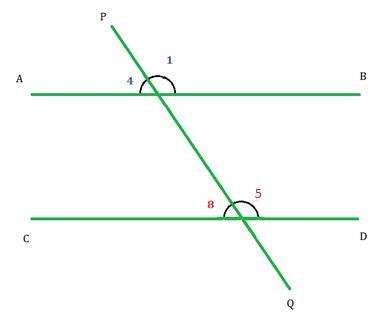
Similarly, An interior angle formed by the transversal line on the first line and an exterior angle formed by the transversal line on the second line on the same side of the transversal line are called corresponding angles.
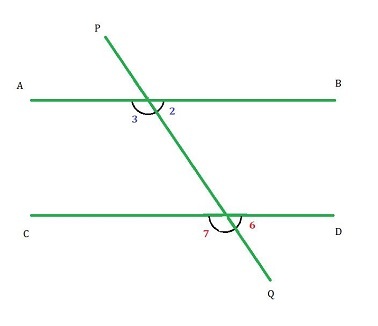
Therefore,$\mathrm{\angle2\:=\:\angle6}$
$\mathrm{\angle3\:=\:\angle7}$
Alternate Angles
Contrary to the corresponding angles, the alternate angle includes the interior angles on either side of the transversal line.
Alternate Interior angles
Interior angles formed on two parallel lines by a transversal line on its opposite sides are known as alternate interior angles. As shown in the figure, $\mathrm{\angle2}$ is an alternate angle to $\mathrm{\angle8}$ and $\mathrm{\angle3}$ is an alternate angle to $\mathrm{\angle5}$.
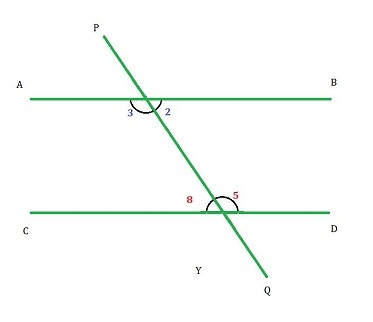
Alternate interior angles formed by parallel lines are equal.
Therefore,$\mathrm{\angle2\:=\:\angle8}$
$\mathrm{\:\:\:\:\:\:\:\:\:\:\:\:\:\:\:\:\:\angle3\:=\:\angle5}$
Alternate Exterior Angles
Exterior angles formed by a transversal line on its either side are known as alternate exterior angles. As shown in the figure, $\mathrm{\angle1}$ is an alternate angle to $\mathrm{\angle7}$, and $\mathrm{\angle4}$ is an alternate angle to $\mathrm{\angle6}$.
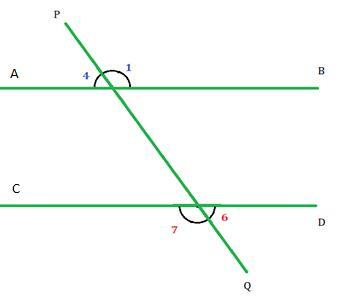
Alternate exterior angles formed by parallel lines are equal.
Therefore, $\mathrm{\angle1\:=\:\angle7}$
$\mathrm{\:\:\:\:\:\:\:\:\:\:\:\:\:\:\:\:\:\:\angle4\:=\:\angle6}$
Angles on the Same Side of Transversal
Interior angles formed on two parallel lines by a transversal line on the same side of the transversal line are called co-interior angles. As shown in the figure, $\mathrm{\angle2}$ is a co-interior angle to $\mathrm{\angle5}$ and $\mathrm{\angle3}$ is a co-interior angle to $\mathrm{\angle8}$.
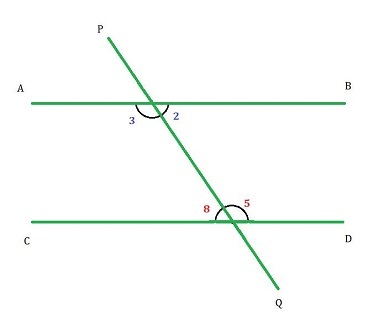
If a transversal cuts two parallel lines, each pair of co-interior angles is supplementary.
Therefore, $\mathrm{\angle2\:+\:\angle5\:=\:180°\:\:\:\:\angle3\:+\:\angle8\:=\:180°}$
Vertically opposite angles
Each angle formed by a transversal line intersecting two parallel lines at two different points is vertically opposite to the angle on its opposite side on the same line. As shown in the figure, $\mathrm{\angle1}$ is vertically opposite to $\mathrm{\angle3}$ on the same line, likewise, $\mathrm{\angle2}$ and $\mathrm{\angle4}$, $\mathrm{\angle5}$ and $\mathrm{\angle7}$, and $\mathrm{\angle6}$ and $\mathrm{\angle8}$.
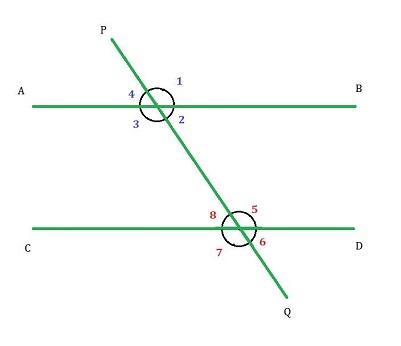
Vertically opposite angles are equal to each other.
Therefore, $\mathrm{\angle1\:=\:\angle3\:,\:\angle2\:=\:\angle4\:,\:\angle5\:=\:\angle7\:,\:\angle6\:=\:\angle8}$
Solved Examples
1) In the figure given below, line AB is parallel to line CD. A transversal line PQ intersects the line at X and Y. If $\mathrm{\angle\:AXP\:=\:60°}$, then find angle $\mathrm{\angle\:PYD}$.
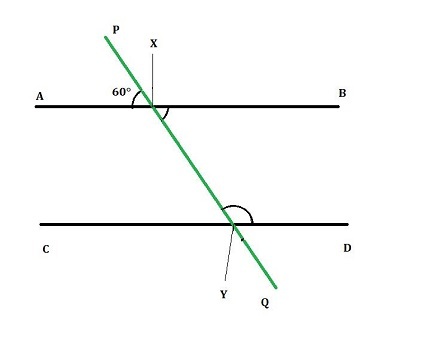
Ans Given, $\mathrm{\angle\:AXP\:=\:60°\:,\:AB\:\:\:\rVert\:\:CD}$
According to the property of transversal lines, vertically opposite angles are equal to each other. Therefore,
$$\mathrm{\angle\:AXP\:=\:\angle\:QXB}$$
$$\mathrm{\angle\:QXB\:=\:60°}$$
According to the property of angle subtended on the same side of transversal,
$$\mathrm{\angle\:QXB\:+\:\angle\:PYD\:=\:180°}$$
$$\mathrm{60°\:+\:\angle\:=\:180°}$$
$$\mathrm{\angle\:PYD\:=\:120°}$$
2) Find x in the given diagram, where lines AB and CD are parallel lines, PQ is a transversal line through them. Given, $\mathrm{\angle\:QXB\:=\:72°}$
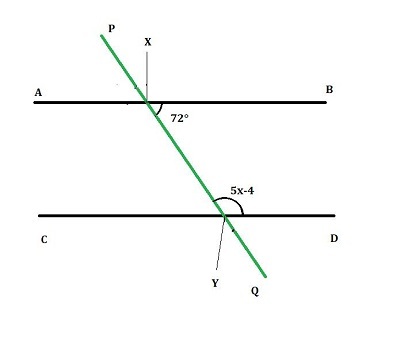
Ans Given that $\mathrm{\angle\:QXB\:=\:72°\:,\:AB\:\:\:\rvert\:\:\:CD\:,\:\angle\:PYD\:=\:5x\:-\:4}$
According to the property of interior angle subtended on the same side of the transversal,
$$\mathrm{\angle\:QXB\:+\:\angle\:PYD\:=\:180°}$$
$$\mathrm{72°\:+\:5x\:-\:4\:=\:180°}$$
$$\mathrm{5x\:-\:4\:=\:108°}$$
$$\mathrm{5x\:=\:112°}$$
$$\mathrm{x\:=\:224°}$$
Conclusion
Lines may be defined as perpendicular, parallel, transversal, etc. Parallel lines are lines which do not intersect each other. Each point in a parallel line is equidistant from its corresponding point in the other line. If two parallel lines in a two-dimensional plane are intersected by a third line at two different points, the third line is known as transversal line. An exterior/interior angle formed by the transversal line on the first line and the interior/exterior angle formed by the transversal line on the second line on the same side of the transversal line are said to be corresponding angles. Interior/exterior angles formed on two parallel lines by a transversal line on its opposite sides are known as alternate angles. Angles opposite each other when a transversal line intersects one of the parallel lines are called vertically opposite angles.
FAQs
1. How many angles are formed when a transversal line cuts through two parallel lines?
Eight angles are formed when a transversal line cuts through two parallel lines.
2. What are corresponding angles?
An exterior/interior angle formed by the transversal line on the first line and the interior/exterior angle formed by the transversal line on the second line on the same side of the transversal line are said to be corresponding angles.
3. How are interior angles related to each other?
Interior angles on the same side of the transversal are supplementary i.e. they have a sum equal to 180°. And interior angles on the opposite sides of the transversal are equal.
4. What are vertically opposite angles?
Angles opposite to each other when a transversal line intersects one of the parallel lines are called vertically opposite angles
5. What are alternate angles?
Interior angles formed on two parallel lines by a transversal line on its opposite sides are known as alternate interior angles.

